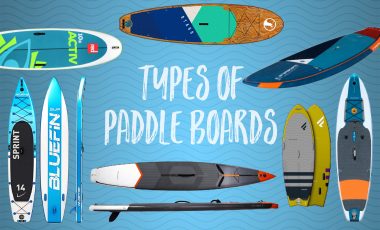Stand-up paddle boarding (SUP) is one of the most accessible and enjoyable ways to get out on the water. While you can hire or borrow a board, the best way to really enjoy all the benefits of paddle boarding is to buy your own.
But, with so many options available, you need to choose wisely between all the different types of paddle boards. Having the right board will add a lot to your enjoyment, while the wrong board could put you off SUP for good.
In this guide, we explain the pros and cons of the various types of paddle boards and also discuss manufacturing materials and how to choose the right paddle board.
Types of paddle boards
Disclaimer: We use affiliate links and may receive a small commission on purchases.
All-round paddle boards
BEST FOR: Beginners – intermediate on flat water
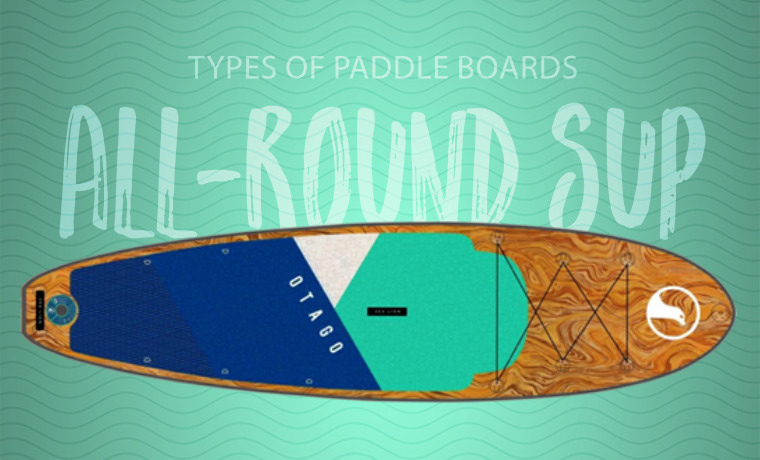 All-round paddle boards are an excellent option for beginners or anyone who doesn’t want to buy a specialist board. They’re stable and manoeuvrable and the ideal board to learn on.
All-round paddle boards are an excellent option for beginners or anyone who doesn’t want to buy a specialist board. They’re stable and manoeuvrable and the ideal board to learn on.However, because they’re also reasonably streamlined, most all-rounder paddle boards are also suitable for more experienced paddlers, although you’ll have to work quite hard to get much speed out of one.
The average all-around paddle board is 32 to 35 inches wide and 10.5 to 11.5 feet long. Longer, narrower boards are faster than wider, shorter ones but can also be a little less stable.
Pros
- Stability
- Turn easily
- Good for novices
- Also suitable for more experienced paddlers
- It can be used on most types of water except surf
Cons
- Quite slow
- Not the best gliders – more work per stroke
Touring paddle boards
BEST FOR: Long distance paddle boarding and overnight expeditions
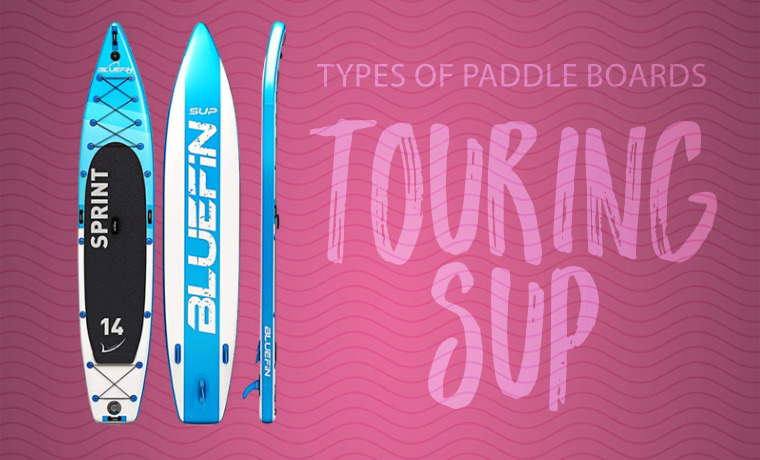 Touring stand-up paddle boards, also known as expedition paddle boards, are longer than all-rounders. That extra length means you can carry more gear, making them ideal paddle boards for camping. Because they are longer and usually a little narrower, they also travel further per stroke and are faster, so you can cover greater distances with less effort.
Touring stand-up paddle boards, also known as expedition paddle boards, are longer than all-rounders. That extra length means you can carry more gear, making them ideal paddle boards for camping. Because they are longer and usually a little narrower, they also travel further per stroke and are faster, so you can cover greater distances with less effort.That said, you don’t have to use a touring paddle board for overnight adventures; they’re also great for fitness paddling or simply travelling further afield than you could on an all-rounder.
Touring SUPs range from 11 to 13 feet long and are usually 30 to 33 inches wide. They also tend to have a big weight capacity, making them ideal for carrying passengers, dogs, and camping gear.
Pros
- A good mixture between stability and performance
- High weight capacity
- Suitable for all levels of paddler
- Travel further with less effort per stroke
Cons
- Not very manoeuvrable
- Can be heavy
Racing paddle boards
BEST FOR: Going fast in competitive / training scenarios
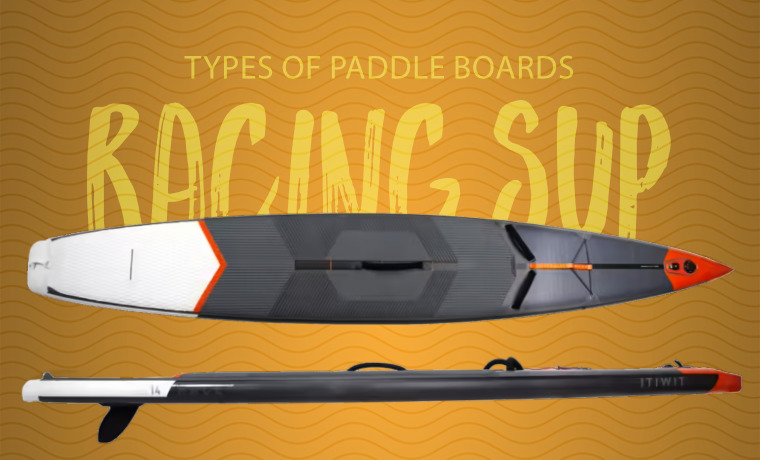 If you feel the need, the need for speed (thanks, Top Gun!), you’ll enjoy using a racing SUP. These performance paddle boards are very long and streamlined, so they slice through the water with ease.
If you feel the need, the need for speed (thanks, Top Gun!), you’ll enjoy using a racing SUP. These performance paddle boards are very long and streamlined, so they slice through the water with ease.Most racing SUPs have a displacement hull rather than a planing hull. This means they’re shaped more like a boat than a flat-bottomed raft. While this is a great feature for speed, it does affect stability and manoeuvrability.
Racing paddle boards are not ideal for beginners, as balancing is much harder than it is for expedition SUPs and all-rounders. But, if you are an experienced paddler, you will love the speed you can only get on a racing board.
The average racing paddle board is 12.5 to 14 feet long and a slender 25 to 29-inches wide.
Pros
- Very fast
- Lightweight
- Long glide per stroke
- Perfect for fitness workouts and racing
- Travel further with less effort
Cons
- Very narrow, which makes balancing more difficult
- Not usually equipped for carrying gear
- Lower weight capacity
Fishing paddle boards
BEST FOR: Fishing!
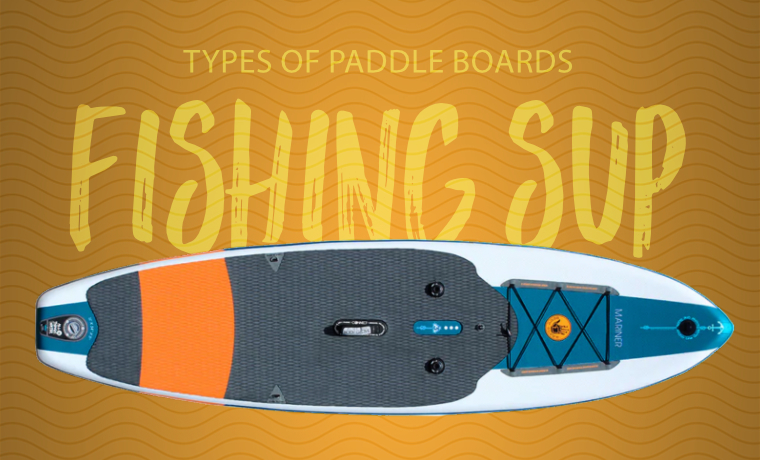 Most fishing paddle boards are all-rounders or touring paddle boards equipped for fishing. They usually have features like rod holders, anchor mounts, and even fixtures for fish finders, seats, and cool boxes.
Most fishing paddle boards are all-rounders or touring paddle boards equipped for fishing. They usually have features like rod holders, anchor mounts, and even fixtures for fish finders, seats, and cool boxes.Paddle board fishing is very popular and allows anglers to fish in places not accessible by boat as they can be used in very shallow water.
That’s not to say you can’t use a fishing SUP for other types of paddling because you can! For example, a fishing board can double as a camping SUP as most have huge weight capacities and are also very stable.
Fishing paddle boards are typically 32 to 36 inches wide and 10.5 to 12 feet wide.
Pros
- Very stable
- High weight capacity
- Equipped to carry fishing equipment
Cons
- Can be heavy
- Not very fast
- Not very manoeuvrable
Yoga paddle boards
BEST FOR: Stability and doing yoga on
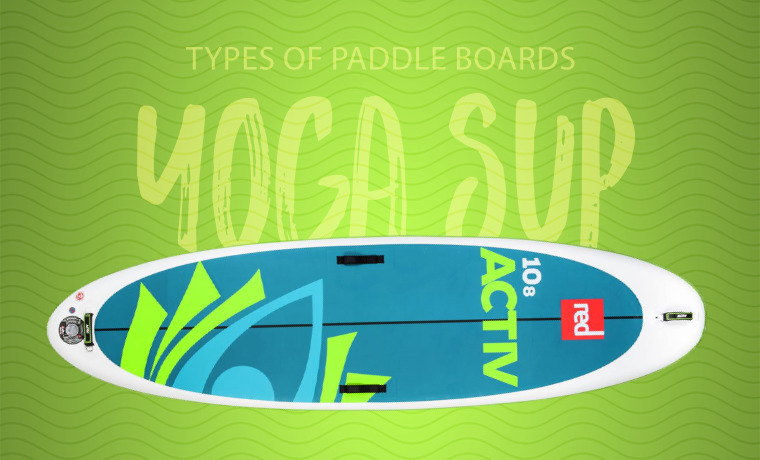 SUP yoga is a popular fitness workout. Combining the stability and balance demands of paddle boarding with the mobility and strength demands of yoga makes for a challenging and rewarding workout.
SUP yoga is a popular fitness workout. Combining the stability and balance demands of paddle boarding with the mobility and strength demands of yoga makes for a challenging and rewarding workout.Needless to say, yoga SUPs are wide and stable, so you get an element of instability but can still perform your yoga poses correctly. Yoga boards are not very fast, streamlined, or agile, but that’s the point; they’re meant to be used more as platforms than transportation.
That said, a yoga stand-up paddle board is similar in performance to an all-rounder, so they’re suitable for short, easy paddles and great for beginners.
Yoga boards are usually 10 to 12 feet long and 32 to 34 inches wide.
Pros
- Very stable
- Suitable for beginners
- High weight capacity
Cons
- Tend to be slow
- Not very manoeuvrable
- Not usually equipped for carrying gear
Surfing paddle board
BEST FOR: Manoeuvrability and catching waves easily
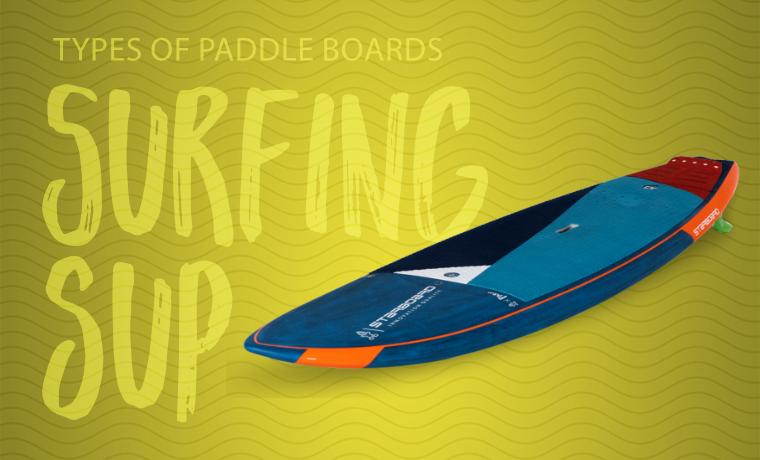 Most paddle boarders prefer relatively calm water and light to moderate winds. Rough seas usually mean spending more time in the water than on it! That said, if you are looking for a more exhilarating take on paddle boarding, you might want to try paddle board surfing.
Most paddle boarders prefer relatively calm water and light to moderate winds. Rough seas usually mean spending more time in the water than on it! That said, if you are looking for a more exhilarating take on paddle boarding, you might want to try paddle board surfing.Stand-up paddle boards for surfing are built more like surfboards than regular paddle boards. They’re short, extremely manoeuvrable, and designed to skim along the face of a wave. Most have three fins to help with stability, but that stability only really kicks in when you pick up speed. At slower speeds, surf SUPs are usually very unstable.
It’s a bad idea to use a regular SUP in surf, so if you want to try this challenging but exciting type of paddle boarding, you’ll definitely need a specialist surfing stand-up paddle board.
Surfing SUPs are usually around 9 to 10 feet long and 29 to 32 inches wide.
Pros
- Very manoeuvrable
- Built for speed
- Designed specifically for surfing
Cons
- Not very stable
- Not really suitable for general paddling
Whitewater paddle boards
BEST FOR: Paddling on fast moving rivers
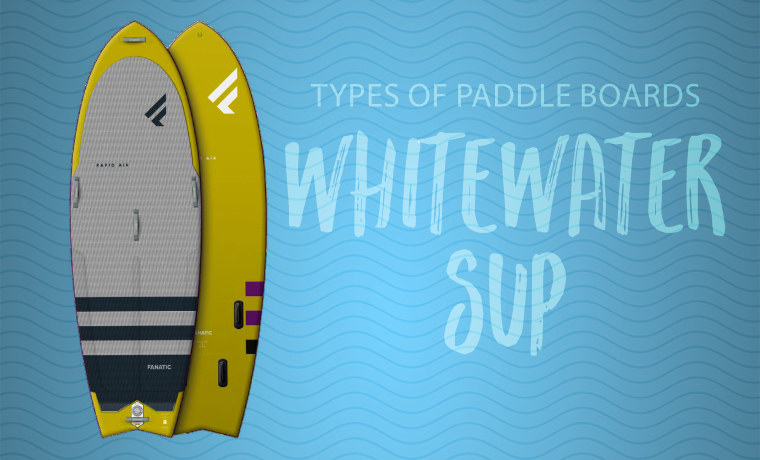 Whitewater SUP boards are made for use on fast-flowing rivers. Like whitewater kayaks, these boards are rugged, short, and easy to manoeuvre, so you can steer around rocks and over drops with ease. Or, if not ease, at least with a degree of competency!
Whitewater SUP boards are made for use on fast-flowing rivers. Like whitewater kayaks, these boards are rugged, short, and easy to manoeuvre, so you can steer around rocks and over drops with ease. Or, if not ease, at least with a degree of competency!Most whitewater river boards are wide and stable and not especially fast. However, as you won’t be gliding through the water but moving with it, this is not really a disadvantage. Most have an upturned nose (called the rocker) which means they are less likely to get snagged on rocks. However, it also reduces the glide potential per stroke.
Whitewater paddle boards range from 8.5 to 11 feet long and are usually about 34 to 46 inches wide.
Paddleboard construction
Most of the paddle board types described above are available in several different materials. So, as well as choosing a board that’s right for the kind of paddling you want to do, you should also consider what your board is made from, as there are pros and cons here, too.
The two main distinctions are inflatable paddle boards and hard paddle boards:
Inflatable SUPs
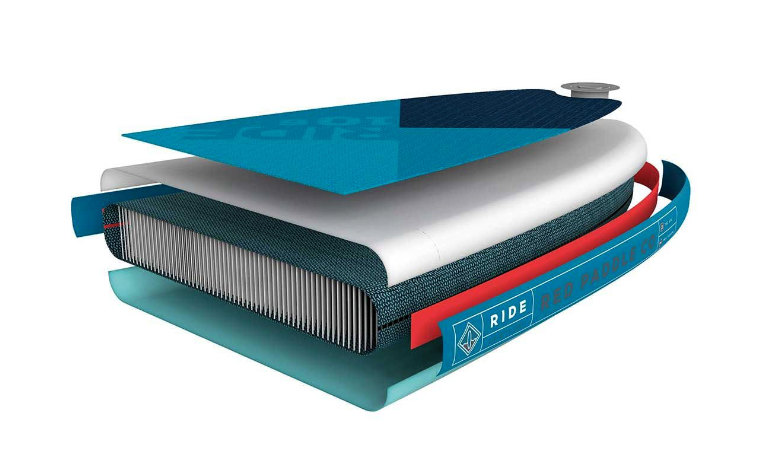 Inflatable SUPs (iSUPs) are made from PVC, Kevlar, and other lightweight but flexible materials. They are made using a construction method called drop-stitching, where the layers are joined together with thousands of vertical threads. This helps keep the board rigid and ensures that it maintains its shape once inflated.
Inflatable SUPs (iSUPs) are made from PVC, Kevlar, and other lightweight but flexible materials. They are made using a construction method called drop-stitching, where the layers are joined together with thousands of vertical threads. This helps keep the board rigid and ensures that it maintains its shape once inflated.
ISUPs used to be seen as inferior to rigid paddle boards, but drop-stitch technology has improved so much in recent years that inflatable boards perform almost as well as hard paddle boards.
ISUPs roll up to fit in a backpack, so they’re compact paddle boards and easy to transport and store. They’re often more stable than rigid boards, and because they have planing rather than displacement hulls, they take a little more effort to push through the water.
However, inflatables are often tougher than fibreglass paddle boards, and you’ll probably just bounce off any rocks you hit instead of smashing a hole in your pride and joy.
Pros
- Lightweight paddle boards
- Easy to store
- No roof rack required
- Easy to repair with glue and patches
- Usually cheaper than hard boards
Cons
- Not quite as fast as the equivalent hard board
- Takes 5-10 minutes to inflate and deflate
- A puncture could be disastrous if you are far from the shore
Hard boards
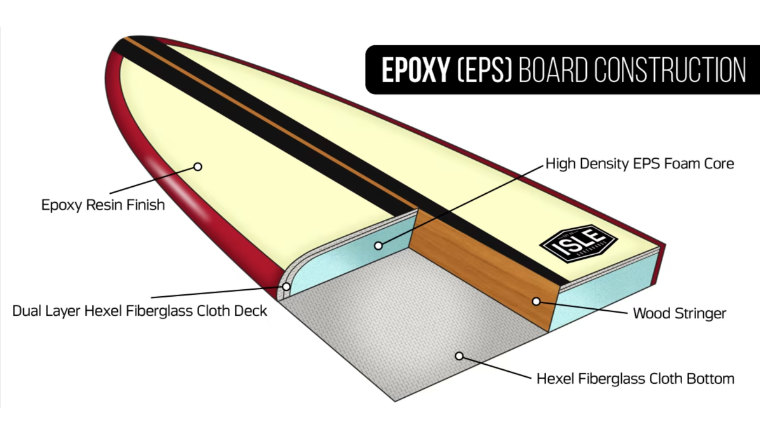 Hard, rigid, or solid paddle boards are made from various materials, including fibreglass, epoxy, wood, or a combination of materials. Hard paddle boards and fibreglass boards are typically very rigid and streamlined, so they tend to be fast and have an excellent glide potential.
Hard, rigid, or solid paddle boards are made from various materials, including fibreglass, epoxy, wood, or a combination of materials. Hard paddle boards and fibreglass boards are typically very rigid and streamlined, so they tend to be fast and have an excellent glide potential.
On the downside, even a gentle contact with a rock could damage your hard board, and unless you can do the repairs yourself, it will usually mean taking your board to a specialist board repairer.
Soft top or composite paddle boards have an epoxy core covered with compressed foam. They’re very rigid but also hardwearing. This type of board is often used at watersports centres for hire. While this type of board is very buoyant, stable, and virtually unsinkable, they tend to be relatively slow and heavy. But the outer foam layer means they will stand up to years of use and abuse.
Pros
- Very rigid
- Usually faster than inflatable paddle boards
- Ready to go without inflation
Cons
- Harder to transport and store
- Except for composite boards, most hard boards are easy to damage
- More complicated to repair than inflatable boards
- Usually more expensive than comparable iSUPs
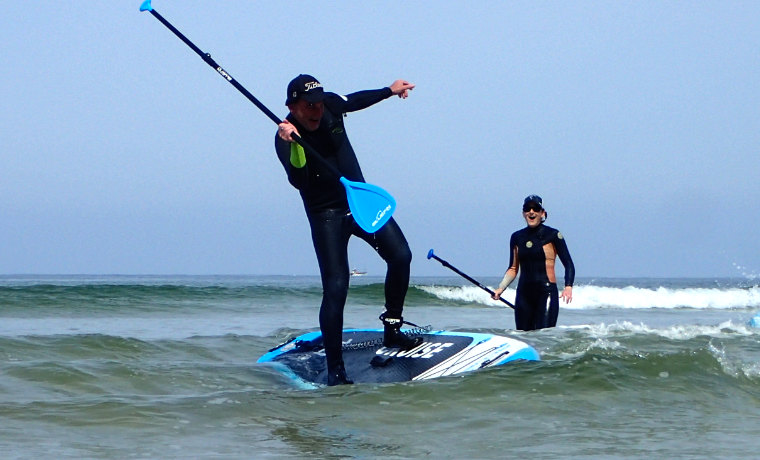
Choosing a stand-up paddle board
Form follows function, or so the saying goes. So, when choosing a paddle board, you should first decide what you want to use it for.
For example, an all-round board would be ideal if you want to cruise slowly around calm bays. But, if you want to travel further using less energy, a touring board would make a better choice. If you want to try your hand at SUP surfing, you’ll need a board made specifically for riding the waves.
Beginners should generally go for shorter, wider boards as they’re more stable and provide a good platform for learning the basics of paddle boarding. But, as you progress from beginner to intermediate, you’ll probably enjoy the freedom that a narrower, faster board offers.
Finally, you need to decide between an inflatable or rigid board. Inflatable boards are a bit of a nuisance to pump up and deflate, but transportation and storage are easy. You’ll need a roof rack to carry a hard board and take extra care not to damage it on any rocks, but most rigid boards are faster than their inflatable counterparts.
Of course, speed also depends on your paddling fitness – it’s not all about the board!
The last thing to consider, and this is a lesson learned from personal experience, is that your paddling skill will improve quickly. A super-wide, stable board can soon become boring and frustratingly slow once you’ve mastered the basics and gained some confidence.
It may be worth buying a board you can “grow into” rather than buying a new one in a few months. As such, a longer, narrower all-rounder or even a medium-width touring board could be the best choice for a beginner.
Types of paddle boards – wrapping up
You’ve now got all the information you need to choose the perfect paddle board. But, if you are still unsure, I strongly suggest you try before you buy. Get some lessons, hire or borrow a few different boards, and see which type you like best. Try rigid and inflatable boards to compare performance.
But, whatever you end up with, I KNOW you’ll love paddle boarding and will enjoy every minute you spend out on the water. Whether cruising, touring, racing or surfing, paddle boarding is one of the best ways to enjoy being out on the water.


